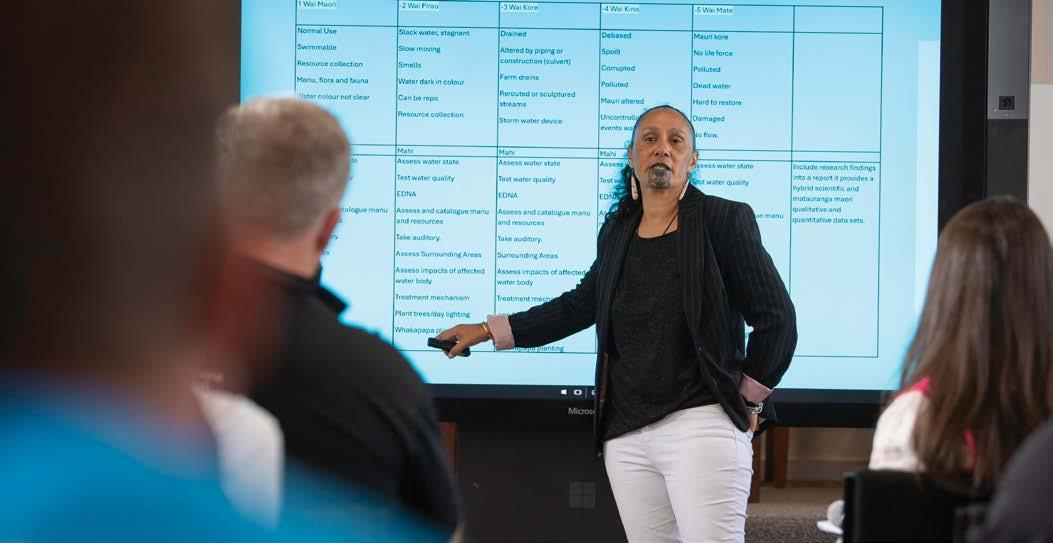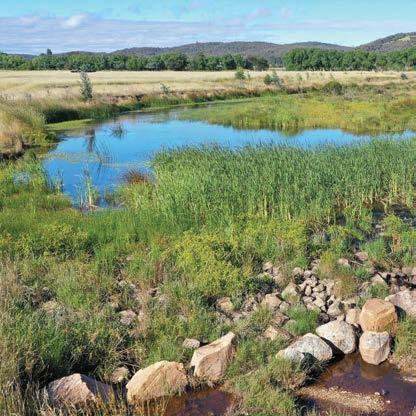
7 minute read
WORKING TOGETHER TO IMPROVE OUR WATERWAYS
A new cultural indicator tool is being developed in Pukekohe as iwi and the horticulture industry work together to improve our waterways. HELENA O’NEILL talks to Edith Tuhimata about her passion project and why this tool is so important for communities as well as the environment.
Edith Tuhimata is one busy woman. For the past 30 years the archaeologist has been working in the environment sector, and more recently has been part of the discussion with growers around the wider Pukekohe area to improve the land and waterways.
Her role is with Ngaati Tamaoho as Kaitiaki Taiao Matua, or senior environmental lead.
“We’ve spent three years sitting in the room with growers and iwi Ngaati Te Ata, Ngaati Tipa, Ngaati Tamaoho, and Waikato-Tainui was in there in an advisory capacity. Three years of negotiating with the growers how to heal our land,” Edith says.
“That’s their bread and butter, that’s our food source for the whole of New Zealand. There were some really tense conversations there… and quite a few times when I suggested it was cup of tea time,” she laughs.
A key aim of Edith’s is to figure out what mechanisms could be put in place to improve the system and help improve waterways and growing areas.
“We started off by completing the integrated management plan for the Pukekohe catchment, all the way around from Bombay to the Manukau Harbour.”
Horticulture New Zealand senior environmental policy advisor Leanne Roberts has been working with mana whenua and growers in Pukekohe for a few years.
“There was a process called the Pukekohe ICMP [Integrated Catchment Management Plan] that went for a number of years,” Leanne says. “Sometimes really confronting and challenging discussions between mana whenua, growers, regional council, central government and industry – the outcome was the creation of a wonderful Pukekohe Action Plan. The result of that process was the formation of Te Tautara o Pukekohe,” Leanne says.
Te Tautara o Pukekohe is governed by representatives from Ngaati Te Ata, Ngaati Tamaoho, Ngaati Tipa, Horticulture New Zealand, and Pukekohe Vegetable Growers Association.
On its website, Te Tautara o Pukekohe says the fertile, friable soils and benign local climate have made the Pukekohe area famous for its ahuwhenua (vegetable growing). Over generations, the Pukekohe catchment has supported the vegetable growing enterprises of a diverse collective of cultures, feeding people with fresh and healthy kai.
Today the area is strategically important for growing fresh vegetables and maintaining food security for New Zealanders. Over time, long-term trends in water quality degradation have been recorded in freshwater flowing within and from Pukekohe.
In November 2021, Sustainable Land Use Ministers approved a multimillion-dollar investment in the Pukekohe SVGA (Specified Vegetable Growing Area) and the catchments of all wai (water) flowing from the area (the Project Focus Area) from the Essential Freshwater Fund (EFF) to fund the development of Mahia te Maheretanga –Te Ora o Te Wai: Pukekohe Action Plan
Edith says even with changes in our growing systems, rehabilitating the land will take 30 years.
“One thing I’ve always thought about is our waterways, all the waterways in this catchment are centred on those growing areas being up the top and everything else going down towards the Manukau Harbour.
“I really thought about a way or mechanism so we could test it ourselves. We could challenge the growers to do better along with ourselves and developers.”
The cultural indicator tool developed by Edith is simple, she says.
“It’s basic, about four pages on an iPad. You just click on it, answer the questions, and then you’ve got your research component. I just wanted it to be simple, no hard thing about it, so that our people can go out to our own lands and do it themselves.
“It’s not only me using the water indicator; I gave it to my cousins at Ngaati Tipa who are doing 21 waterways on the Onewhero side of the Waikato River. Myself, I am doing the interior from Bombay to Pukekohe, all the way down to the Manukau Harbour. My cousin Roi with Ngaati Te Ata, he does the West Coast side of it down the Āwhitu Peninsula. I was trying get the best bang for our buck. But the findings we’re getting out of the three areas are huge.”
Speaking at the inaugural Vegetables Big Day Out hosted by Te Ahikawariki back in March about the cultural indicator tool, Edith was surprised by the interest shown by growers and the industry.
“They have been really enthusiastic about it. There were some good, articulate questions that some of the young landowners asked me – I had to really think about it because you have to remember the indicator is in its infancy. But it’s probably the only indicator that has a true collaborative component to it – the scientific world does its bit and we do our bit, and the outcome of that is awesome.
“There’s a bit of hype about it now. I said I was going to do a whenua one, a cultural indicator to test the land, and then the growers sort of took me up on that. Now we’re doing the whenua one just to keep the growers on point.”
Leanne says she has been through the tool a couple of times, and says it’s amazing.
“When you look at it, simplicity doesn’t do justice to the thinking behind it. From a user perspective when you look at the tool, it gives you a really simple way to be able to look and assess a waterway using the things that were really important traditionally, and it’s been really grounded in some good scientific indicators.
“When growers have seen it, I’ve had feedback that it’s amazing and ‘I could use this, this is brilliant’. For me, I just looked at it and it’s such a good time marker and legacy, designed in such a way that Edith’s children and grandchildren could pick this up decades from now and get this amazing picture about what has been going on and what the improvements have been in freshwater over that time.”

Leanne says users should be able to pick that up, use it, analyse it, and get a really good sense on where something has come from.
“We’ve seen the most beautiful, unintended benefit where there has been this closeness from the young people coming through, connection with the environment and kaumātua kuia coming through and telling the stories of the place. A real community benefit is that people are becoming more aware and connected with their place and space.”
For Edith, her role means she is balancing two world views which don’t always align.
“I’m stuck between the two worlds – the environmental knowledge and the cultural knowledge. To bring up the understanding of Mātauranga Māori in my scientific world is really important because we are scientists in our own right as well.”
Mātauranga Māori refers to the knowledge, wisdom, and understanding within Māori culture, encompassing traditional practices, cultural values, and worldviews.
“The one thing that binds us all together is the love we have for our people, the love that we have for our land, and the love that we have for our waterways. It’s the one thing that makes a difference … to give their grandchildren something better.”










